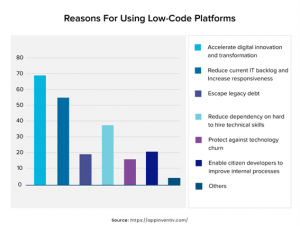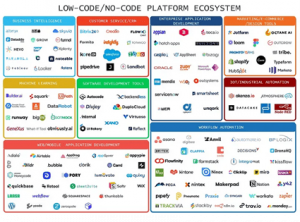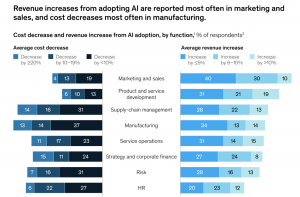How AI and Low-code are changing the way
applications are built, used and maintained.
A few years ago, the software development world was rocked by a new, revolutionary approach to coding: not doing it at all.
Driven by the need to keep up with fast changing tech and the ever present goal of saving time and money, many companies were lured by the speed, ease, and off-the-shelf approach of low-code platforms such as OutSystems and countless others. Suddenly, managers were asking questions like “is my business a software business?” (even if they worked in, say, agriculture) or “can anyone in my organization really develop applications?” (even if they employed zero programmers)? It seemed promising – until it all changed, once again, with AI.
The combination of AI with low-code platforms opens up a world of possibilities, democratizing access to the creation of innovative applications and solutions. Hey, why not ask chat-GPT to build you a CRM? That customer portal you’ve been working on for years? Just use any number of low-code templates and customize them with AI. No wonder Nvidia’s CEO recent proclaimed that “coding is dead”.
Could it really be that easy?
Even though AI and low-code are a recent mix, they are already widely used, so it is possible to discern a few really great ways to use them – and a lot of potential risks to avoid.
What is low-code and how does it work?
Low-code is a software development concept that goes something like this: what if you could create applications, websites, and other platforms using little to no code. It was created in 2014 as a response to the demand for simpler and more accessible software development solutions.

Low-code platforms are highly visual and intuitive, employing a drag-and-drop model that removes the need to write complex code. They come with a set of pre-configured components, making it easy to build information flows, present data attractively, or automate actions. You can use them to build a number of applications: for instance, build workflow automation in a matter of days or weeks, instead of months, ensuring seamless integration across all systems in a personalized manner. Or you could build your own project management tool, customized to your needs (say adieu to old Trello boards or Asana lists). Building the CRM or ERP of your dreams is also possible. And the list goes on and on.

To do so, you’ll need a low-code platform. That’s the platform you’ll use to actually build the applications and picking the right one is essential. Each has its own pros and cons and is geared towards specific use cases. OutSystems, for instance, is one of the leading low-code platforms driving this digital transformation. Using this platform, we’ve built, deployed and managed countless enterprise mobile and web applications incredibly quickly.
Take FINHAUS, a real estate lending digital transformation company. We helped them streamline their data recovery and approval process, reducing their initial timeframe from six months to a maximum of two weeks. We also supported Kinda Home in modernizing their management and logistics systems. That included developing a mobile frontend for stock control in stores and integrating with multiple logistics transportation companies. Human resources departments can also benefit from a low-code approach. For example, NOS contacted us to develop a human resources application able to manage and create users, permissions, and roles, as well as automatically send emails and SMS to users with alerts and relevant information. We also automated the creation of mailboxes, as well as the management and creation of shared folders.
When AI met low-code
Around 77% of companies are either using or exploring the use of AI in their businesses.
But AI could play an even larger role when combined with low-code – like suggest alternative software designs or help you write complex business logic rules and processes. Here are a few of the most promising applications.
AI can help developers streamline the entire low-code application lifecycle
One of the most significant trends shaping the future of AI and low-code is the increasing integration of AI-driven automation throughout the entire application development lifecycle. From initial design and prototyping to deployment and maintenance, AI-enabled low-code platforms will empower developers to automate mundane tasks, accelerate development cycles, and focus on solving higher-order problems.
AI can help low-code application users automate routine tasks
AI in low-code allows you to automate various processes, from document management to data analysis and report generation. For example, a human resources department can create and implement an automated recruitment system that analyzes CVs, conducts virtual interviews, and recommends candidates based on predefined criteria. This speeds up hiring, reduces human bias, and increases operational efficiency.

For sales and marketing teams, AI in low-code can automate email campaigns, generate personalized commercial proposals, and free up time for analysts and salespeople to nurture relationships with leads and customers. We recently developed a mobile application for Certis Group to manage employee absences and expenses.
AI enables users to interact with low-code apps in entirely new ways
What if you could query your own company database for the latest marketing or sales figures? What if your clients had the ability to “ask” the app (instead of you) for the launch date of the next email campaign? AI can breathe new ways for users to interact with apps, replacing the need to search, process and analyze raw data and tables. These tools facilitate the exchange of information between companies, employees, and customers, serving an efficient communication channel that operates 24/7.
Users can get more from the data in their low-code apps
Data analysis is also essential for decision-making in any company. Low-code platforms with integrated AI make it easier to analyze large volumes of data in real time. For instance, low-code systems using natural language processing algorithms can analyze large volumes of structured or unstructured data to identify trends, common issues, and opportunities for service improvement. It can also generate reports and alerts without previously defined rules – a major difference versus traditional development.
AI enhances low-code app design
Incorporating AI into low-code platforms can revolutionize software development by suggesting alternative design approaches and optimizing user interfaces. For instance, AI algorithms can analyze user behavior data to suggest optimal layouts for web pages or mobile applications. By considering factors such as user engagement metrics and usability principles, AI can recommend changes to improve the layout’s effectiveness in guiding users towards desired actions.
AI-powered low-code platforms can dynamically adapt user interfaces based on individual preferences, behavior patterns, or demographics. For instance, an e-commerce website can personalize product recommendations, navigation menus, and content layout to enhance each user’s shopping experience. AI can assist designers in creating visually appealing interfaces by suggesting color schemes, typography choices, and graphic elements.
AI can streamline writing advanced logic
AI-powered low-code platforms can also assist in writing complex business logic rules and optimizing workflow processes. For instance, AI algorithms can analyze large datasets and historical patterns to automate decision-making processes within the application. For instance, in a financial application, AI can predict credit risk scores or recommend investment strategies based on market trends and user preferences.
Low-code platforms with AI capabilities can automate repetitive tasks and enforce business rules without manual intervention. For example, in an inventory management system, AI can trigger reorder alerts based on predefined inventory thresholds and supplier lead times. Low-code platforms integrated with NLP capabilities can interpret and process human language inputs, enabling chatbots or virtual assistants to understand user queries and perform actions accordingly. For example, in a customer service application, AI-powered chatbots can respond to customer inquiries, escalate issues to human agents when necessary, and update relevant records in real-time.
AI can even optimize workflow processes by analyzing task dependencies, resource availability, and performance metrics. For instance, in a project management application, AI can dynamically allocate resources, adjust task priorities, and identify potential bottlenecks to ensure timely project delivery and resource efficiency.
Cons of using AI in low code
Organizational culture and the complexity of the technological infrastructure can pose significant obstacles. These are some of AI in low-code limitations.
Costs
For many companies, the costs associated with implementing new digital technologies can be prohibitive. Additionally, calculating and guaranteeing a tangible and measurable return on investment can be complex, making it difficult to justify these expenses.
Learning curve
Despite the simplicity of low-code platforms, a certain level of familiarity with AI concepts and software development is still required to use the technology effectively.
Transparency and understanding
It is important to be clear about how AI algorithms are making decisions, what data is being used, and in what way. A lack of transparency can lead to trust issues and make it difficult to identify errors or biases in AI models. When using AI in low-code, it is extremely important to guarantee the security and privacy of the data used during the development and operation of each project.
Maintenance and updating
AI models need regular maintenance and updating to ensure that they continue to function accurately and efficiently. This requires specific resources and expertise.
The Future Convergence of AI and Low-Code Platforms
As we look ahead, it’s becoming increasingly evident that the future of software development lies at the intersection of artificial intelligence and low-code platforms. These two transformative technologies are poised to merge seamlessly, blurring the lines between them and fundamentally reshaping the way applications are built and deployed.
With AI embedded directly into the low-code environment, developers can leverage advanced machine learning algorithms to automate repetitive tasks, optimize design decisions, and enhance the functionality of their applications. As AI algorithms continue to evolve and become more sophisticated, we can expect low-code platforms to incorporate increasingly advanced AI capabilities, such as natural language processing, computer vision, and predictive analytics. This convergence will enable developers to build applications that are not only intelligent but also capable of understanding and adapting to user behavior in real-time.
Ultimately, the convergence of AI and low-code platforms holds immense potential to democratize software development, making it more accessible and empowering a new generation of developers. As this convergence continues to unfold, we can expect to see a wave of AI-powered applications that are smarter, faster, and more capable than ever before.
Near Partner, experts at low-code and AI
Looking for the right low-code / AI partner? At Near Partner, we have helped dozens of organizations develop digitally through low-code tools combined with AI. By integrating low-code with artificial intelligence, companies accelerate their digital maturity while redefining the standards of excellence in their respective sectors. Not sure how to start? Get in touch! We want to help your business grow.





